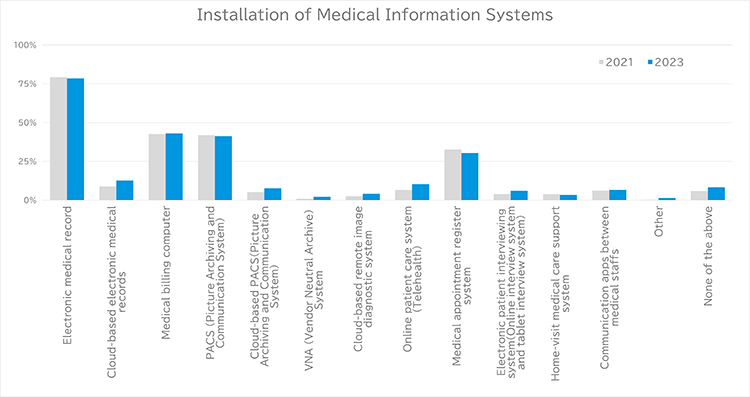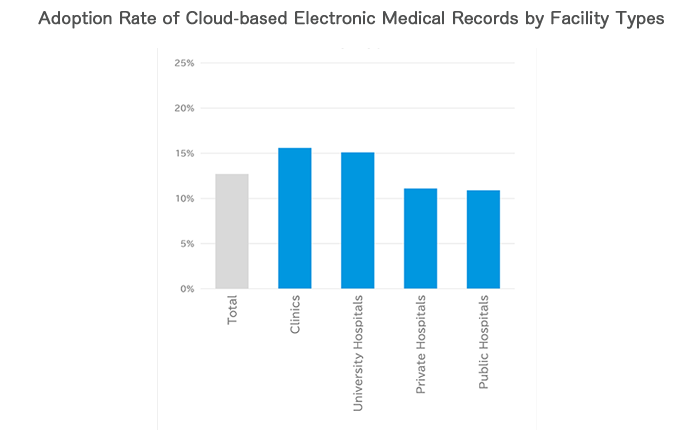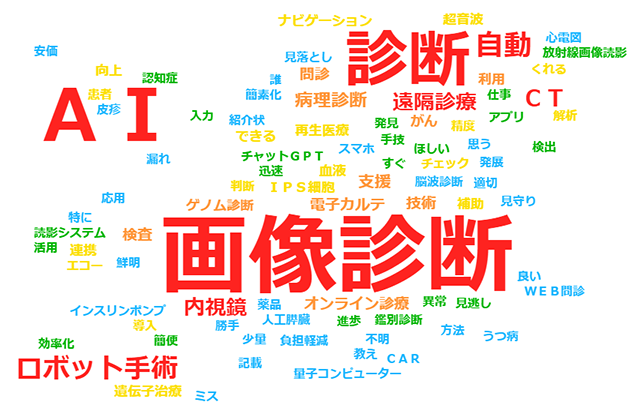Electronic Medical Records Going Cloud — High Expectations for AI Diagnostic Imaging
Survey on Medical Information System Implementation
At the forefront of healthcare, big data needs to be processed while dealing with patients. The implementation of information systems and utilizing fully digital technology has become essential.
To understand the actual distribution of such systems, Nikkei Research conducted a survey in March 2023, targeting registered Nikkei Medical Online members, a community run by Nikkei BP, and asking them about the "status of medical information systems implementation" at their workplaces (medical institutions).
The survey results showed that the installment of electronic medical records and other systems is steadily growing, and expectations for cutting-edge digital technologies such as "AI" and "robotics" are increasing.
Electronic medical records are becoming popular even in clinics
5,593 physicians who work at university hospitals, clinics, and other general hospitals participated in the survey. When asked about the medical information systems installed at their facilities, 78.5% of the total said they already have on-premise types of electronic medical records installed, and 12.7% said they have cloud types.

According to Japan's Ministry of Health, Labour and Welfare, 91.2% of general hospitals with over 400 beds and 49.9% of clinics have electronic medical records in 2020.
Our survey results show that over 95% of university hospitals and slightly under 64% of clinics confirmed that they have electronic medical records. Indicating that regardless of the size of the medical facility, the use of electronic medical records is gaining popularity.
Among our survey results, the most notable would be the growing implementation of cloud-based electronic medical records. In a similar survey conducted by Nikkei Research in August 2021 (4,508 respondents), 79.3% of medical institutions possessed an on-premise type, while the cloud type's adoption rate was only 8.9%.
While the rate of the on-premise type fell 0.8 points from this previous survey, the cloud type rose 3.8 points. By type of facility, small clinics had the highest adoption rate of cloud-based electronic medical records at 15.8%, followed by university hospitals at 15.1%. Compared to the 2021 survey, they gained 5.6 points and 5.8 points, respectively.

The cloud-based system reduces the time and cost of placing and managing servers and other equipment in the medical facility. It also has the advantage of sharing patient information easily across the facility and physicians. On the other hand, many healthcare professionals have pointed out the risks of exchanging medical information over the Internet.
More than 10 years have passed since the lift of the ban on the use of cloud services in the medical field in Japan, and we can see gradually some institutions are taking the benefits of clouds. Where on-premise systems' functionalities are also improving, medical institutions are choosing on-premise or cloud depending on their regional aspects or fields of expertise.
The "cloud shift" is not limited to electronic medical records, but extends to PACS (picture archiving and communication system) alike. In our survey, 41.2% of physicians said they have an on-premise PACS, down 0.7 points from the previous survey in 2021. On the other hand, the cloud-based PACS was 7.7%, up 2 points. The adoption rate of the "online patient care system (telehealth)," which drew attention amidst the difficulty of patients coming to the hospital during COVID, was 10.3%, an increase of 3.7 points from the 2021 survey.
Overwhelming needs for AI Diagnostic Imaging
The respondents were also asked about "anticipated technologies to come" in an open-ended question. The following image is the word cloud of responses.

By the word frequency, "diagnostic imaging" was the most common (29.7%), followed by "AI" (23.7%) and "diagnosis" (19.9%). Looking through the comments, it is clear that the majority of physicians are seeking "AI-based diagnostic imaging technology."
In Japan, where the popularity of CT scans and MRI are top-in-the-world, diagnosis using images is common throughout hospitals and small clinics. There is a growing need for extremely busy physicians to have AI help image diagnosis more quickly and accurately. In addition, there is a serious shortage of "specialists in reading medical imaging" in university hospitals and other core regional hospitals, where a more advanced diagnosis is required. They are long awaiting the development of AI systems that can reduce the workload of these specialists.
The term "automatic" (6.5%) and "robotic surgery" (6.4%) may be the next most prominent. It appears that surgeons have high expectations for surgical robots and navigation systems such as the "da Vinci Surgical System." Among the open-ended responses, the demand for advanced technologies that can streamline work, such as "care robots" and "voice input medical records" also stood out. In Japan, where the population is declining and aging, the shortage of labor in medical and nursing care is becoming more and more intense. We can say our survey results are reflecting the reality of difficulties in Japan.
The next article will focus on the challenges of having AI used widely.
please contact us below.

